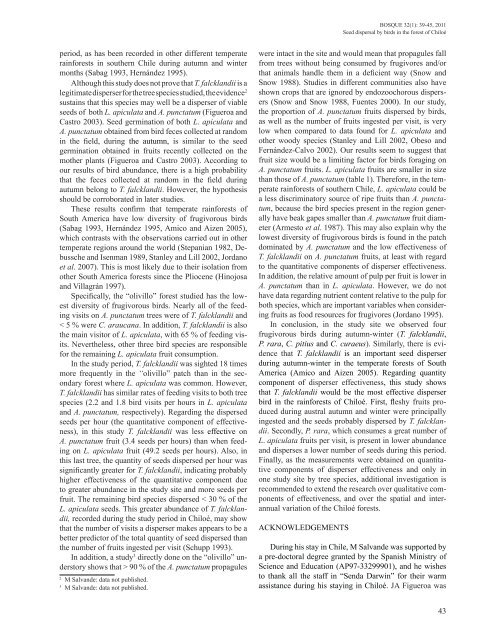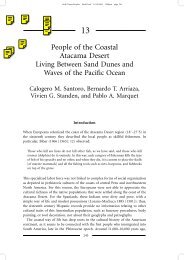Quantity component of the effectiveness of seed dispersal by birds in ...
Quantity component of the effectiveness of seed dispersal by birds in ...
Quantity component of the effectiveness of seed dispersal by birds in ...
You also want an ePaper? Increase the reach of your titles
YUMPU automatically turns print PDFs into web optimized ePapers that Google loves.
BOSQUE 32(1): 39-45, 2011Seed <strong>dispersal</strong> <strong>by</strong> <strong>birds</strong> <strong>in</strong> <strong>the</strong> forest <strong>of</strong> Chiloéperiod, as has been recorded <strong>in</strong> o<strong>the</strong>r different temperatera<strong>in</strong>forests <strong>in</strong> sou<strong>the</strong>rn Chile dur<strong>in</strong>g autumn and w<strong>in</strong>termonths (Sabag 1993, Hernández 1995).Although this study does not prove that T. falcklandii is alegitimate disperser for <strong>the</strong> tree species studied, <strong>the</strong> evidence 2susta<strong>in</strong>s that this species may well be a disperser <strong>of</strong> viable<strong>seed</strong>s <strong>of</strong> both L. apiculata and A. punctatum (Figueroa andCastro 2003). Seed germ<strong>in</strong>ation <strong>of</strong> both L. apiculata andA. punctatum obta<strong>in</strong>ed from bird feces collected at random<strong>in</strong> <strong>the</strong> field, dur<strong>in</strong>g <strong>the</strong> autumn, is similar to <strong>the</strong> <strong>seed</strong>germ<strong>in</strong>ation obta<strong>in</strong>ed <strong>in</strong> fruits recently collected on <strong>the</strong>mo<strong>the</strong>r plants (Figueroa and Castro 2003). Accord<strong>in</strong>g toour results <strong>of</strong> bird abundance, <strong>the</strong>re is a high probabilitythat <strong>the</strong> feces collected at random <strong>in</strong> <strong>the</strong> field dur<strong>in</strong>gautumn belong to T. falcklandii. However, <strong>the</strong> hypo<strong>the</strong>sisshould be corroborated <strong>in</strong> later studies.These results confirm that temperate ra<strong>in</strong>forests <strong>of</strong>South America have low diversity <strong>of</strong> frugivorous <strong>birds</strong>(Sabag 1993, Hernández 1995, Amico and Aizen 2005),which contrasts with <strong>the</strong> observations carried out <strong>in</strong> o<strong>the</strong>rtemperate regions around <strong>the</strong> world (Stepanian 1982, Debusscheand Isenman 1989, Stanley and Lill 2002, Jordanoet al. 2007). This is most likely due to <strong>the</strong>ir isolation fromo<strong>the</strong>r South America forests s<strong>in</strong>ce <strong>the</strong> Pliocene (H<strong>in</strong>ojosaand Villagrán 1997).Specifically, <strong>the</strong> “olivillo” forest studied has <strong>the</strong> lowestdiversity <strong>of</strong> frugivorous <strong>birds</strong>. Nearly all <strong>of</strong> <strong>the</strong> feed<strong>in</strong>gvisits on A. punctatum trees were <strong>of</strong> T. falcklandii and< 5 % were C. araucana. In addition, T. falcklandii is also<strong>the</strong> ma<strong>in</strong> visitor <strong>of</strong> L. apiculata, with 65 % <strong>of</strong> feed<strong>in</strong>g visits.Never<strong>the</strong>less, o<strong>the</strong>r three bird species are responsiblefor <strong>the</strong> rema<strong>in</strong><strong>in</strong>g L. apiculata fruit consumption.In <strong>the</strong> study period, T. falcklandii was sighted 18 timesmore frequently <strong>in</strong> <strong>the</strong> “olivillo” patch than <strong>in</strong> <strong>the</strong> secondaryforest where L. apiculata was common. However,T. falcklandii has similar rates <strong>of</strong> feed<strong>in</strong>g visits to both treespecies (2.2 and 1.8 bird visits per hours <strong>in</strong> L. apiculataand A. punctatum, respectively). Regard<strong>in</strong>g <strong>the</strong> dispersed<strong>seed</strong>s per hour (<strong>the</strong> quantitative <strong>component</strong> <strong>of</strong> <strong>effectiveness</strong>),<strong>in</strong> this study T. falcklandii was less effective onA. punctatum fruit (3.4 <strong>seed</strong>s per hours) than when feed<strong>in</strong>gon L. apiculata fruit (49.2 <strong>seed</strong>s per hours). Also, <strong>in</strong>this last tree, <strong>the</strong> quantity <strong>of</strong> <strong>seed</strong>s dispersed per hour wassignificantly greater for T. falcklandii, <strong>in</strong>dicat<strong>in</strong>g probablyhigher <strong>effectiveness</strong> <strong>of</strong> <strong>the</strong> quantitative <strong>component</strong> dueto greater abundance <strong>in</strong> <strong>the</strong> study site and more <strong>seed</strong>s perfruit. The rema<strong>in</strong><strong>in</strong>g bird species dispersed < 30 % <strong>of</strong> <strong>the</strong>L. apiculata <strong>seed</strong>s. This greater abundance <strong>of</strong> T. falcklandii,recorded dur<strong>in</strong>g <strong>the</strong> study period <strong>in</strong> Chiloé, may showthat <strong>the</strong> number <strong>of</strong> visits a disperser makes appears to be abetter predictor <strong>of</strong> <strong>the</strong> total quantity <strong>of</strong> <strong>seed</strong> dispersed than<strong>the</strong> number <strong>of</strong> fruits <strong>in</strong>gested per visit (Schupp 1993).In addition, a study 3 directly done on <strong>the</strong> “olivillo” understoryshows that > 90 % <strong>of</strong> <strong>the</strong> A. punctatum propagules2M Salvande: data not published.3M Salvande: data not published.were <strong>in</strong>tact <strong>in</strong> <strong>the</strong> site and would mean that propagules fallfrom trees without be<strong>in</strong>g consumed <strong>by</strong> frugivores and/orthat animals handle <strong>the</strong>m <strong>in</strong> a deficient way (Snow andSnow 1988). Studies <strong>in</strong> different communities also haveshown crops that are ignored <strong>by</strong> endozoochorous dispersers(Snow and Snow 1988, Fuentes 2000). In our study,<strong>the</strong> proportion <strong>of</strong> A. punctatum fruits dispersed <strong>by</strong> <strong>birds</strong>,as well as <strong>the</strong> number <strong>of</strong> fruits <strong>in</strong>gested per visit, is verylow when compared to data found for L. apiculata ando<strong>the</strong>r woody species (Stanley and Lill 2002, Obeso andFernández-Calvo 2002). Our results seem to suggest thatfruit size would be a limit<strong>in</strong>g factor for <strong>birds</strong> forag<strong>in</strong>g onA. punctatum fruits. L. apiculata fruits are smaller <strong>in</strong> sizethan those <strong>of</strong> A. punctatum (table 1). Therefore, <strong>in</strong> <strong>the</strong> temperatera<strong>in</strong>forests <strong>of</strong> sou<strong>the</strong>rn Chile, L. apiculata could bea less discrim<strong>in</strong>atory source <strong>of</strong> ripe fruits than A. punctatum,because <strong>the</strong> bird species present <strong>in</strong> <strong>the</strong> region generallyhave beak gapes smaller than A. punctatum fruit diameter(Armesto et al. 1987). This may also expla<strong>in</strong> why <strong>the</strong>lowest diversity <strong>of</strong> frugivorous <strong>birds</strong> is found <strong>in</strong> <strong>the</strong> patchdom<strong>in</strong>ated <strong>by</strong> A. punctatum and <strong>the</strong> low <strong>effectiveness</strong> <strong>of</strong>T. falcklandii on A. punctatum fruits, at least with regardto <strong>the</strong> quantitative <strong>component</strong>s <strong>of</strong> disperser <strong>effectiveness</strong>.In addition, <strong>the</strong> relative amount <strong>of</strong> pulp per fruit is lower <strong>in</strong>A. punctatum than <strong>in</strong> L. apiculata. However, we do nothave data regard<strong>in</strong>g nutrient content relative to <strong>the</strong> pulp forboth species, which are important variables when consider<strong>in</strong>gfruits as food resources for frugivores (Jordano 1995).In conclusion, <strong>in</strong> <strong>the</strong> study site we observed fourfrugivorous <strong>birds</strong> dur<strong>in</strong>g autumn-w<strong>in</strong>ter (T. falcklandii,P. rara, C. pitius and C. curaeus). Similarly, <strong>the</strong>re is evidencethat T. falcklandii is an important <strong>seed</strong> disperserdur<strong>in</strong>g autumn-w<strong>in</strong>ter <strong>in</strong> <strong>the</strong> temperate forests <strong>of</strong> SouthAmerica (Amico and Aizen 2005). Regard<strong>in</strong>g quantity<strong>component</strong> <strong>of</strong> disperser <strong>effectiveness</strong>, this study showsthat T. falcklandii would be <strong>the</strong> most effective disperserbird <strong>in</strong> <strong>the</strong> ra<strong>in</strong>forests <strong>of</strong> Chiloé. First, fleshy fruits produceddur<strong>in</strong>g austral autumn and w<strong>in</strong>ter were pr<strong>in</strong>cipally<strong>in</strong>gested and <strong>the</strong> <strong>seed</strong>s probably dispersed <strong>by</strong> T. falcklandii.Secondly, P. rara, which consumes a great number <strong>of</strong>L. apiculata fruits per visit, is present <strong>in</strong> lower abundanceand disperses a lower number <strong>of</strong> <strong>seed</strong>s dur<strong>in</strong>g this period.F<strong>in</strong>ally, as <strong>the</strong> measurements were obta<strong>in</strong>ed on quantitative<strong>component</strong>s <strong>of</strong> disperser <strong>effectiveness</strong> and only <strong>in</strong>one study site <strong>by</strong> tree species, additional <strong>in</strong>vestigation isrecommended to extend <strong>the</strong> research over qualitative <strong>component</strong>s<strong>of</strong> <strong>effectiveness</strong>, and over <strong>the</strong> spatial and <strong>in</strong>terannualvariation <strong>of</strong> <strong>the</strong> Chiloé forests.ACKNOWLEDGEMENTSDur<strong>in</strong>g his stay <strong>in</strong> Chile, M Salvande was supported <strong>by</strong>a pre-doctoral degree granted <strong>by</strong> <strong>the</strong> Spanish M<strong>in</strong>istry <strong>of</strong>Science and Education (AP97-33299901), and he wishesto thank all <strong>the</strong> staff <strong>in</strong> “Senda Darw<strong>in</strong>” for <strong>the</strong>ir warmassistance dur<strong>in</strong>g his stay<strong>in</strong>g <strong>in</strong> Chiloé. JA Figueroa was43
















